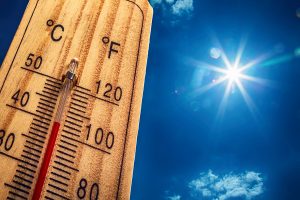A tragic news story recently would have been avoidable by preventing heat stroke. Two toddler twin sisters were left alone in a hot car for a short period of time. Then the father remembered that he had left the children in the car. He attempted to revive them from heat stroke, but it was too late. Both children died.
Heat stroke seems like a subject that should be on anybody’s mind during the summer period.
We don’t normally realize how frail life can be, but when it comes to overheating from a heat wave, from a hot car, from a lack of air conditioning in a house or even when camping in the summer. The step from overheating to death is very small!
What is heat stroke and what are the symptoms of it?
With heat exposure on a summer day, our body temperature consequently elevates. It is a gradual process, yet this happens easier, if we do not drink enough fluids getting dehydrated. Our body develops a fever, which our vital organs (the brain, the heart and kidneys) do not easily withstand. Once our core temperature exceeds 105 degrees Fahrenheit (40.55 degrees Celsius) we are entering the danger zone of developing heat stroke.
Fainting or a throbbing headache may be one of the first symptoms. The person may complain about dizziness or lightheadedness. There could be a lack of sweating and the skin maybe dry, hot and red. The muscles may get weak and there may be muscle cramps. The person may experience vomiting and nausea. The heartbeat can be fast and breathing may be shallow and rapid. The person may get confused and start staggering. Seizures can suddenly happen and the person can become unconscious.
First aid for preventing heat stroke
A person has been identified to possibly have a heat stroke. The paramedics have been called. While waiting, it is important to apply measures to lower the core temperature. If the person is conscious, a quick way to lower the body temperature is a prolonged, cold shower or a cool bath. If the patient cannot be moved, wetting the skin and using an air fan will cool the body. Apply ice packs to the armpits, the groins, the neck and back. Blood vessels are close to the skin in these areas, which will helps cooling the body temperature.
Recognize risk factors for preventing heat stroke
Heat stroke occurs more commonly in people above the age of 50 and below the age of 4 (see example above). But even athletes who push themselves to the limit in sunny conditions while getting dehydrated have a risk of getting heat stroke. Preventing heat stroke means we need to always drink enough fluids to stay hydrated and avoid excessive sun exposure.
There are other risk factors. People with heart, liver and kidney disease have a greater risk of developing heat stroke. Take extra cool showers intermittently on a hot day, if you do not have air conditioning. Get a cool mister. Check your urine color. If it is dark, you are getting dehydrated and you must drink more fluids until you produce light-colored urine.
Conclusion
Preventing heat stroke is a must. This is particularly important during hot summer temperatures. Never leave children or pets in hot cars; they are the most vulnerable to develop heat stroke. Even a few minutes may be too much! Stay hydrated with fluids. Stay indoors in air-conditioned premises. If you do not have air-conditioning, take frequent cool showers or cool baths. If you have access to a pool or a swimming area, take a cool dip. Once you recovered from heat stroke, remember that your system is vulnerable for at least another week. Ask your physician when it is safe for you to go to the sunny outdoors. Bear in mind that too much sun and too much heat can quickly turn into a health hazard!







